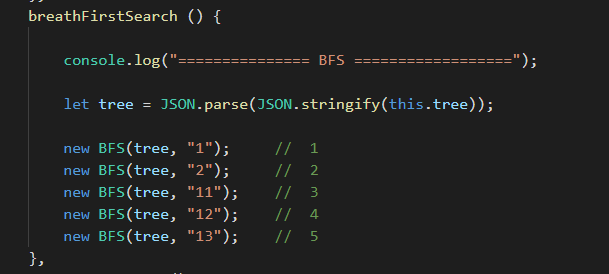休息了一个月,本月开始正常更新,这一篇来聊一下DFS和BFS。
首先大致提一下这两个英文单词首字母缩写的含义。
DFS(Deep First Search):即深度优先搜索
BFS(Breath First Search):即广度优先搜索(遍历)
在一些科幻的电视或小说中,可能经常会遇到这样的情景,主角跟着一群伙伴去探宝,但宝物不是那么容易拿的,有一道道的关卡,甚至这之中不乏有生门,死门这样可能选错再也没有回头路的关口,怎样走才能走到目的地,取到宝物呢?
通常有两种做法:
第一种,往某一条路一直走,走到黑,等发现没有宝物再折(回溯)回来,继续往另一条路一直走走到黑,如此一直循环并最终找到宝物。
这种做法强调的是关卡的深度。此时程序扫描的路径是往深处扫描的,除非碰到这条路径的最尽头,此时回源头继续往;另一条路径上扫
第二种:派出多个人分各条路去走,每走一关随时汇报情况。
这种做法强调的是关卡的广度。此时程序扫描的路径是从最外层
这个其实说的就是DFS 和 BFS。
BFS跟DFS在树结构的遍历或检索中非常常见,我们一起来写一个DFS和BFS的实现过程,体会一下这两个优秀的搜索思想。
这是我们要搜索的树结构,假设我现在想要搜索到id为1111的那条数据的name值。
tree.js
export const Tree = [
{
id: "1",
name: "xiaoming",
children: [
{
id: "11",
name: "xiaohua",
children: [
{
id: "111",
name: "xiaohong",
children: [
{
id: "1111",
name: "xiaoqiang",
children: [
{
id: "11111",
name: "xiaozhao"
},
{
id: "11112",
name: "xiaoxin"
},
]
}
]
}
]
},
{
id: "12",
name: "xiaotian",
children: [
{
id: "121",
name: "xiaohe"
}
]
},
{
id: "13",
name: "xiaoli",
children: [
{
id: "131",
name: "xiaobing",
children: [
{
id: "1311",
name: "xiaoqin"
}
]
}
]
},
]
},
{
id: "2",
name: "xiaoyi",
children: [
{
id: "21",
name: "xiaobi",
children: [
{
id: "211",
name: "xiaosheng",
children: [
{
id: "2111",
name: "xiaoguang",
children: [
{
id: "21111",
name: "xiaomi"
},
{
id: "21112",
name: "xiaoxing"
},
]
}
]
}
]
},
{
id: "22",
name: "xiaozhong",
children: [
{
id: "221",
name: "xiaoqing"
}
]
},
{
id: "23",
name: "xiaogua",
children: [
{
id: "231",
name: "xiaoguai",
children: [
{
id: "2311",
name: "xiaolin"
}
]
}
]
},
]
}
]
上面是一个很常见的树结构简化版。
要找到我们想要的那条目标数据,通过BFS,来查找会怎样呢?看看:
export class BFS {
constructor (tree, target) {
this.tree = tree;
this.flag = true;
this.count = 0;
this.init(target);
}
init (target) {
this.flag && this.breathFirst(this.tree, target);
console.log("this.count = " + this.count);
}
breathFirst (nodeList, target) {
let nextNodeList = [];
for(let item of nodeList) {
this.count ++;
if(item.id === target) {
console.log(item.name);
this.flag = false;
return;
}
if( !!item.children && item.children.length) {
nextNodeList.push(...item.children);
}
}
this.flag && nextNodeList.length && this.breathFirst(nextNodeList, target);
}
}
BFS: 广度优先,你会发现最终程序的扫描是扫到1,接着扫描到2,这时候第一层的扫完了,开始扫第二层,一直下去…广度在这里的优先级更高。
而它的实现其实也不难,就是需要一个动态的数组,去储存每一层中所有路径上关卡的信息,并用于下一次的继续探索。
再来看一下DFS深度优先,
export class DFS {
constructor (tree, target) {
this.tree = tree;
this.count = 0;
this.flag = true;
this.init(target);
}
init (target) {
this.tree.forEach(item => {
// 可以尝试一下这里的目标id传入11112跟12的区别,可以很简单的看出11112的this.count更小,深度优先
// this.flag && this.deepFirst(item, "11112");
this.flag && this.deepFirst(item, target);
});
console.log("this.count = " + this.count);
}
deepFirst (node, target) {
this.count ++;
if(node.id === target) {
console.log(node.name);
this.flag = false;
return;
}
if( !!node.children && !!node.children.length ) {
node.children.forEach(item => this.flag && this.deepFirst(item, target));
}
}
}
DFS,这时候你可以发现深度遍历是先扫描到1,1这里这条路径还没有到尽头,继续走,到11,继续直到11111的时候撞墙了,才会回头。深度在这里是受到优先待遇的。
而它的实现很简单很粗暴,一条路径不就是一直是if有children,go,并且不断的将children里的各项作为新的参数递归传递给同一函数,当碰到目标值,直接return出来就好了。这个过程如果目标值是唯一的,那直接像设置一个flag值也就OK了。如果不唯一其实也好办,直接给扫描到的目标值加标记就好了,等多个目标值全部都是新标记的,则是程序跳出执行的时候。至于拿到目标之后需要做什么,则由各自的业务去决定了。
说到这,关于DFS和BFS,其实还有另一个更为形象的现实例子,那就是 —— 剥玉米。
你有若干个玉米,玉米本身还有很多层,某个玉米有一层被涂上了红色的标记,现在你需要找到这一层
此时:
深度优先(DFS)的意思就是你先随机抽一个玉米,一层层的剥皮,直到尽头若还没有红色标记,继续拿剩余的玉米重复操作。强调的是深
广度优先(BFS)的意思则是你将所有的玉米都先剥出来一层皮,看看有没有有红色标记的,没有,继续剥第二层,一直下去…。强调的是广
而这两者的性能是根据实际情况不同而不同的,如果某些业务场景,假如可以预见目标出现的层数级别不会很深,此时采用BFS可能效果更好。
而在一些结构偏窄且更为深的树结构上,此时采用DFS可能可以更快达到目的。
这样一想,DFS跟BFS是不是其实没有什么,挺好理解的,对不?
最后补充一下上面代码的入口与调用。
import { Tree } from './tree.js';
import { DFS } from './DFS.js';
import { BFS } from './BFS.js';
export const Api = {
init () {
this.tree = Tree;
this.breathFirstSearch();
this.deepFirstSearch();
},
breathFirstSearch () {
console.log("=============== BFS ==================");
let tree = JSON.parse(JSON.stringify(this.tree));
new BFS(tree, "1"); // 1
new BFS(tree, "2"); // 2
new BFS(tree, "11"); // 3
new BFS(tree, "12"); // 4
new BFS(tree, "13"); // 5
},
deepFirstSearch () {
console.log("=============== DFS ==================");
let tree = JSON.parse(JSON.stringify(this.tree));
new DFS(tree, "1"); // 1
new DFS(tree, "11"); // 2
new DFS(tree, "111"); // 3
new DFS(tree, "1111"); // 4
new DFS(tree, "11111"); // 5
}
}
共同学习,写下你的评论
评论加载中...
作者其他优质文章







